#Tanker aircraft
Text

Catching a tanker while en route to North Dakota
46 notes
·
View notes
Text

#military#aircraft#air force#us air force#usaf#kc 10 extender#tanker aircraft#aerial refueling plane#f 35a lightning ii#f 35 lightning ii
111 notes
·
View notes
Text
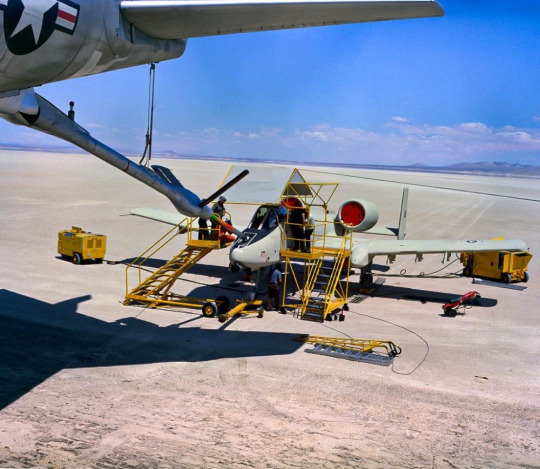
"Practice makes perfect..."
Mid-flight refueling testing for the YA-10 Thunderbolt II with a KC-135 Stratotanker
26 notes
·
View notes
Photo
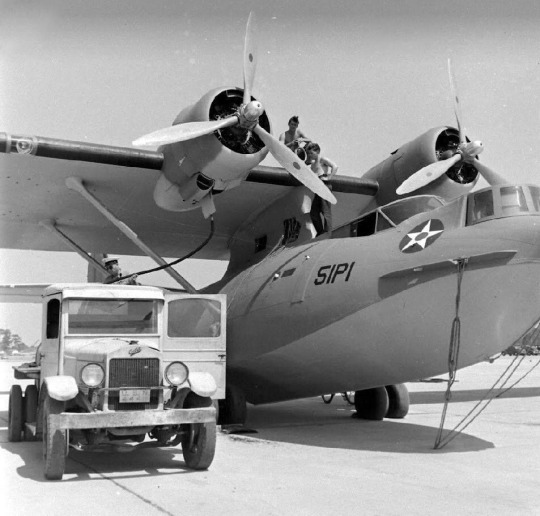
Consolidated PBY Catalina. With fuel truck
#Consolidated#PBY#Catalina#floatplane#flying boat#rescue aircraft#military aircraft#naval aircraft#WW2 aircraft#fuel truck#tanker#bowser
243 notes
·
View notes
Photo

Handley Page Victor from my kofi page where you too can donate to suggest some planes https://ko-fi.com/planeyboys
52 notes
·
View notes
Text
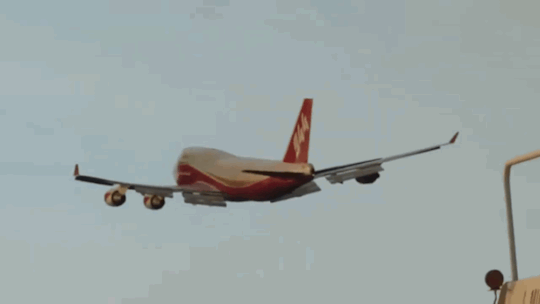
#animated gif#animated gifs#747#firefighter#firefighting aircraft#tanker#gif#gifs#water#super soaker#fire#forest fire#smokey would be proud
12 notes
·
View notes
Text
Boeing KC-135 Stratotanker Heavy Aircraft

The first aircraft flew in August 1956 and the initial production Stratotanker was delivered to Castle Air Force Base, Calif., in June 1957. The last KC-135 was delivered to the Air Force in 1965. Of the original KC-135As, more than 417 were modified with new CFM-56 engines produced by CFM-International.
#kc135#air force#stratotanker#aviation#tanker#pilot#aircraft#kc 135#military#usaf#refueling#boom operator#airplane#air refueling#nkawtg#tanker gas#plane#afb#kc 135 stratotanker#jet#air to air#avgeek#military base#fighter jet#us armed forces#boeing#boom#fairford#135#fighter pilot
0 notes
Text
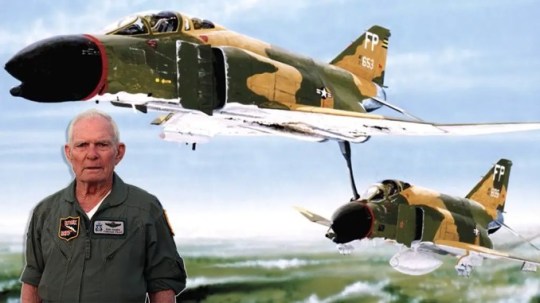
Legendary Pilot Bob Pardo, Who Pushed A Damaged F-4 With His F-4 Over Vietnam, Has Died
December 20, 2023 Military Aviation
Bob Pardo
Bob Pardo in a 2017 photo by Senior Airman Ridge Shan. In the background, Pardo's Push in an artwork by S.W. Ferguson.
Bob Pardo passed away earlier this month at the age of 89. With his Phantom, he pushed a crippled F-4 outside the enemy airspace in one of the most heroic missions in the history of military aviation, known as “Pardo’s Push”.
“Pardo’s Push” is the name of an incredible maneuver carried out during the Air War over North Vietnam that, over the years, has become the symbol of heroism and a demonstration of courage and contempt for danger.
March 10, 1967.
Captain Bob Pardo is flying in an F-4C with Weapon Systems Officer 1st Lt Steve Wayne. Their wingman is the F-4C flown by Captain Earl Aman with Weapon Systems Officer 1st Lt Robert Houghton. The two Phantoms of the 8th Tactical Fighter Wing, based at Ubon Royal Thai Air Force Base, Thailand, are assigned the task to attack a steel mill in North Vietnam north of the capital Hanoi.
During the approach to the target, both F-4 is hit multiple times by enemy’s anti-aircraft fire. The North Vietnamese flak causes significant damage to Capt. Aman’s aircraft whose fuel tank begins to leak fuel forcing the crew to abort the mission. While hit too, Pardo’s F-4 is able to continue its mission.
On their egress route, at 20,000 feet, Aman and Houghton determine that they do not have enough fuel to reach a tanker or Laos, where they could eject and avoid capture. Although his F-4 is still efficient and has enough fuel to reach a tanker, Pardo decides to remain with his wingman.
At a certain point, while still inside North Vietnamese airspace, Aman’s Phantom flames out. To save Aman and Houghton, Pardo decides to do something he believes no one has ever done before: he attempts to push the other F-4 to Laos.
Initially, Pardo tries to push the other F-4 by gently making contact with the drag chute compartment. However, turbulence interferes with the maneuver and after several failed attempts, Pardo opts for an extreme solution: he instructs Aman to lower his tailhook, then he positions his F-4 behind the other Phantom leaning his windscreen against the tailhook. The contact is made but the “solution” is quite unstable and, as a consequence of turbulence, Pardo needs to reposition his F-4 every 15 to 30 seconds. Nevertheless, the push works and rate of descent of Aman’s Phantom is considerably reduced.
As if the situation was not complicate enough, Pardo’s F-4 suffers an engine fire, forcing him to shut it down.
Try for a second to visualize the situation: a flame-out F-4 is somehow pushed by means of its tailhook by another F-4 powered by a single engine. In enemy airspace. Incredible.
Ezoic
Pardo pushes Aman’s F-4 for another 10 minutes until his Phantom runs out of fuel too. With both planes safely inside Laotian airspace, at an altitude of about 6,000 feet, the aircrews of both F-4s ejects (they will be rescued by SAR helicopters and evade capture).
Although he saved another aircrew, Pardo was initially reprimanded for not saving his own F-4. Until 1989, when the episode was re-examinated and both Pardo and Wayne were awarded the Silver Star.
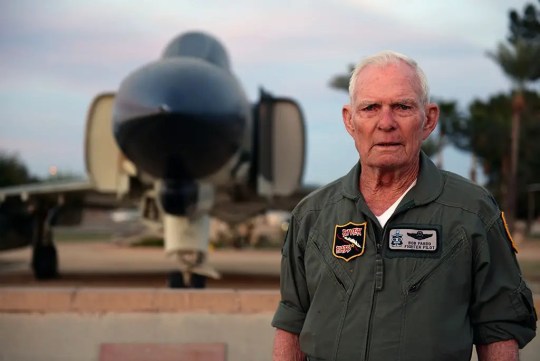
Retired Air Force pilot Lt. Col. Bob Pardo poses in front of a static display model of an F-4 Phantom II, one of the many fighter aircraft he has flown, at Luke Air Force Base, Ariz., Dec. 12, 2017. (U.S. Air Force photo/Senior Airman Ridge Shan)
Pardo and Aman both continued serving and retired from the U.S. Air Force in the rank of lieutenant colonel. Years later, after learning that Aman had lost his voice and mobility because of Lou Gehrig’s disease, created the Earl Aman Foundation that raised enough money to buy Aman a voice synthesizer, a motorized wheelchair, and a computer. The foundation later contributed to raise funds to pay for a van, which Aman used for transportation until his death. In other words, Pardo never left his wingman behind, not even after retiring.
Ezoic
Noteworthy, as told by John L. Frisbee in his 1996 article for Air Force Magazine, Pardo’s push was not the first time a U.S. pilot pushed another jet out of enemy airspace: in 1952, during the Korean War, fighter ace Robbie Risner pushed his wingman out of North Korea in an F-86. However, pilots were ordered to refrain from attempting the hazardous maneuver again, and the episode had faded from memory and was almost completely unknown within the Air Force by the time Pardo and Wayne pushed Aman and Houghton outside of North Vietnam’s airspace.
Bob Pardo passed away aged 89, on Dec. 5, 2023. His courage and ingenuity, along with the legendary “Pardo’s Push“, will be remembered forever.
About David Cenciotti
David Cenciotti is a journalist based in Rome, Italy. He is the Founder and Editor of “The Aviationist”, one of the world’s most famous and read military aviation blogs. Since 1996, he has written for major worldwide magazines, including Air Forces Monthly, Combat Aircraft, and many others, covering aviation, defense, war, industry, intelligence, crime and cyberwar. He has reported from the U.S., Europe, Australia and Syria, and flown several combat planes with different air forces. He is a former 2nd Lt. of the Italian Air Force, a private pilot and a graduate in Computer Engineering. He has written five books and contributed to many more ones.
@Aviationist via X
447 notes
·
View notes
Text
Phantom Friday... passes gas.

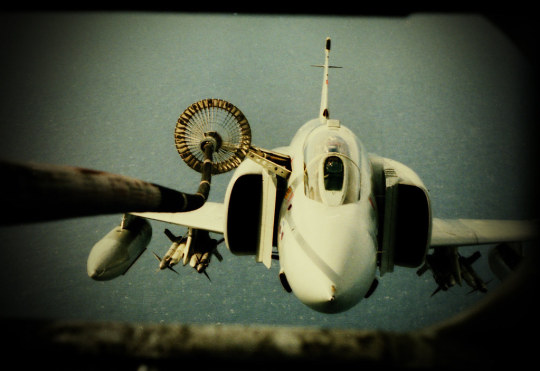
Mid-air refueling is critical for Naval aviation. It allows aircraft to take off with a full weapons load and top off fuel on the way to the target, and also allows for much longer missions.
Navy aircraft use the "hose and drogue" system. The tanker unreels a hose on the end of which is a basket that looks like a giant badminton birdie. The customer aircraft flies up to the basket and inserts a probe mounted on the aircraft...
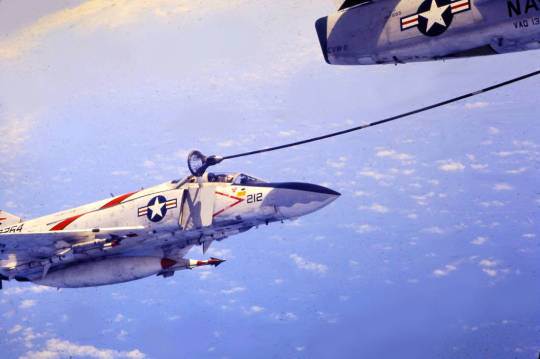
...to get his fuel.
There were dedicated tanker aircraft like the KA-3 and KA-6...


... and also the "buddy store" pod (a pod with some fuel and a hose reel) that would allow any aircraft to be a tanker, like the little A-4...
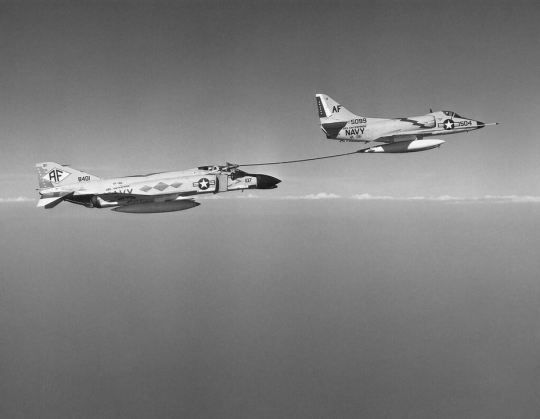
... and even a Phantom.

It's a hard skill to learn. The basket on the hose might be dancing around in turbulence and even be pushed around by the slipstream of the receiving aircraft. Doing it at night makes it even harder. A whipping hose and basket can pose a danger to the potential customer, and sometimes bad things happen.

Lt Kueland was quick to remind the rest of the squadron in the ready room that Navy aircraft didn't have flight controls in the rear cockpit, so this wasn't his fault.
(If you suspect that I made this entire post just to use that last image and tell that feeble joke, I suspect you may be right.)
39 notes
·
View notes
Note
Hii Merc, could I please request #11. "the lover in the sky" for Fred and Brady? Thank you <3 — @shoshiwrites
Thanks for letting me take my time on this one, @shoshiwrites! I hope you don't mind Fred's having...a bit of a crisis.
There was a shiver in the air.
Fred hefted the empty coffee thermos into the back of the jeep, grateful that it had been a busy day and the thing was mostly empty. She was glad she'd thought to bring her tanker jacket, earlier - the warm one with the good zipper that fit nicely over her uniform coat. Summer was still cool, and night out on the tarmac cooler still. She'd left Ken and his crews with fresh coffee, the last of the day, and now it was time for home, and bath, and bed.
"Fred!" Lieutenant Brady's voice came up out of the rising dark. "What brings you out here?"
"Passing out the rest of the coffee. Ken said it was going to be a long night." She paused, and followed his eyes in the direction of the plane, Brady's Crash Wagon in large friendly letters on the side. (Everyone had heard that story, about how he'd brought the thing in from Greenland on no wheels, and they'd renamed it shortly after.) "I could ask you the same thing."
"Checking in on her," he said with a smile. "Looks pretty good, doesn't she?"
"I wouldn't know," Fred admitted with a good-natured shrug. "I've never been inside one." Not even for a little barnstorm, she wanted to add, before someone starting laughing about the absurdity of working at at airbase and never having actually been inside a plane. City girls don't take plane rides at county fairs - and Clubmobile women take boats to Europe.
Brady, however, wasn't laughing. "Do you want to?" he asked, sincere as anything. She snorted, and then realized he was serious, and shrugged in assent. "Are your fellows all done inside, Herb?" Brady asked, shouting under the belly towards the mechanic and his box of tools.
"It's your ship, Lieutenant," Herb said. "I'll leave the stairs out, for when you both need to come back down. You got a flashlight? It's getting mighty dark out here."
Brady waved his and Herb nodded and let them be, Brady steering her towards the tail of the plane and the hatch with its folded down stairs. "Here, you'd better take this," he said, handing over the flashlight, warm from his pocket. "Once you get up top, go along the gangway and watch your feet."
"Don't you want to go first?"
He shook his head. "Ladies first," he said, and waved her on forward.
It was dark, here in the tail of the fort, the only light the two large panels in the sides with their machine guns standing at the ready. She fumbled for a moment with the flashlight until it finally turned on, the small beam casting here and there over the inside of the plane. It felt like being inside the attic of an old house, seeing the ribs of the aircraft jutting out of the walls at regular intervals, the panel of the floor creaking as she made her way around the guns and the bubble of the turret and its enormous oxygen tank, carefully passing by a chair and radio to an even smaller gangway, and passing between an enormous empty space. "Bomb bay," she heard Brady say behind her. "Careful there, there's a step up past the turret. Go left once you're up there."
The step up was over a large opening that must have led to the nose - the light was slightly better down there. Fred hoisted herself up and tried not to move anything, flipping the flashlight off to appreciate the scene in the last bit of light from the sunset. All of this to put a piece of metal in the sky.
Brady climbed up into the right-hand seat, pleased as anything. "How on earth do you manage all of this all at once?" Fred said, trying to make sense of the buttons and switches, each with a name and label more arcane than the last.
"It's just practice," he offered, "A lot of flight hours. And there's a checklist we go through when we start - fuel levels, pumps, ignition switches. Then we pump and prime the engines and start them one by one. Put your hand here," he said, gesturing to the handle between the two seats. "When we're ready on the runway for takeoff, you'd push this forward -" his hand closed around hers on the double-handled throttle - "and away she goes."
She felt strangely powerful, her hand gripping the bar of the throttle, empowered by the feeling of his hand on top of hers. "So," he said. "What do you think?"
Fred looked out the windows once more. Around them the airfield was deep orange and purple, the sun nearly finished setting over the distant tops of the trees. They weren't all that high up, here in the cockpit, but it was still somehow both wonderful and strange to see the field from this height, and pick out the lights just starting to come on in the distance, the pairs of headlights winking and swerving out of the gates.
"Amazing," she said, her voice full of emotions she didn't know she had. All of this could go up into the sky, and fly and fight and come back down again. Day after day, week after week. Hundreds of men, in hundreds of planes, all of it part of one vast, uncountable effort, beautiful and yet terrible in its beauty.
She looked over at Brady, sitting sideways in the copilot's seat, one foot dangling over the door below, and didn't even have time to think about what was happening before he'd leaned over and kissed her right in the middle of her laughing lips.
Time stopped for a moment, and for a bare second it was only the two of them in the dark, breathing together, lips warm.
"You look so pretty now," he offered, almost breathless. And then his smile fell, and the light went out of his eyes. "Fred, please, say something."
There was pressure behind her temples, a high whine between her ears, a magneto that wasn't powering on. Words failed to connect. "…I think I need to leave."
She didn't quite know where she was going - she'd left the flashlight up front with him. She stumbled down out of the cockpit, taking the easiest route out and launching herself out of the pilot's door onto the dark ground below, the asphalt jarring her knees and eating into her hands.
Somewhere behind her she heard him call her name in the dark, but she was starting the jeep and fumbling it into first, hands shaking against the wheel and feeling like her whole heart was about to burst in her chest the same way she had in the cockpit, filled to the brim with the thought of all that love and all those lovers in the sky.
Her heart was still pounding when she parked and made her way back to the Clubmobile, leaning her forehead against its smooth, safe metal side. It's against the rules. This is against the rules. He kissed me. John Brady kissed me.
And the loudest, strongest thought of all - no one told us at training what to do when you don't know if you don't mind.
#asked and answered#shoshiwrites#tds cinematic universe#freda torvaldsen#i have written a thing#mercurygraypresents#john brady x oc#masters of the air oc
44 notes
·
View notes
Text
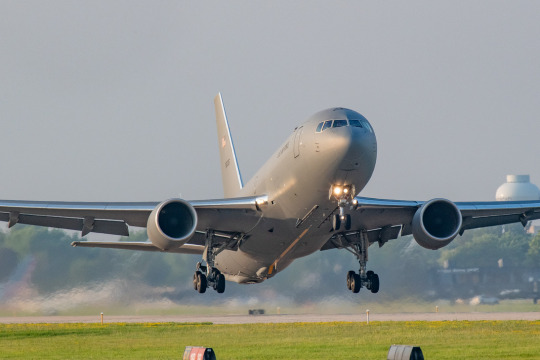
KC-46 departing OSHKOSH
#Boeing#KC-46#Pegasus#Military aviation#Cargo plane#Tanker aircraft#Oshkosh#airshow photos#AirVentures#airplane
23 notes
·
View notes
Text

#military#aircraft#air force#us air force#usaf#kc 10 extender#f 16 fighting falcon#f 16#fighter jet#tanker aircraft#tanker#aerial refueling plane
18 notes
·
View notes
Text
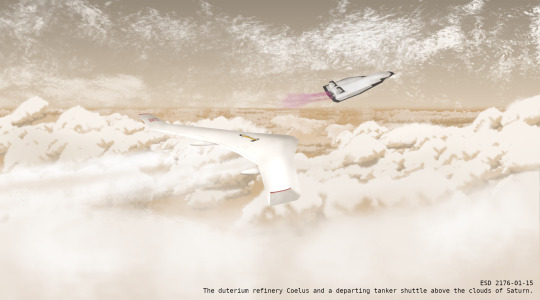
The clouds of saturn have proven themselves the perfect place for the refining of deuterium on vast scales. The lack of a surface means any atmospheric refineries need to be supported by massive nuclear powered aircraft, which stay aloft continuously and occasionally ship their product to orbit via a tanker spaceplane.
18 notes
·
View notes
Text
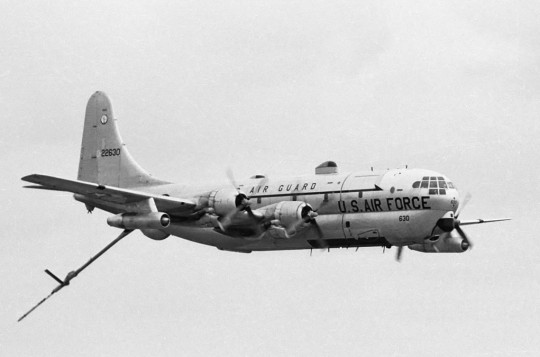
Boeing KC-97L Stratofreighter. OHNG. At RAF Greenham Common EGVI. In 1974
31 notes
·
View notes
Text
🎭 PURIM morning - ISRAEL REALTIME - Connecting to Israel in Realtime (Sunday)
🎉 Happy Purim! May we merit miracles like Purim today, may the blessings of Purim bring our hostages home, our soldiers complete success, and the downfall of our enemies like Purim past.
A day to hear the Megillah Esther, to celebrate, but also to pray for our hostages, our soldiers, our survival!
🔻Air attacks on Israeli civilians…
Rockets x 50 - from Hezbollah, Lebanon - at Snir & Odem
Rockets - from Hamas, Gaza - at Nir Oz
Suicide Drone - from Syria - at South Golan / Kinerret - - FALSE ALARM.
▪️ISIS LEARNS FROM HAMAS.. the (supposed) ISIS terrorists who perpetrated the terrible terror attack in Russia were streaming, and the organization has now published multiple videos (not shared here) that are being redistributed by terror supporting channels - - JUST LIKE HAMAS on the Oct. 7 massacre.
▪️IDF ATTACKS DEEP LEBANON.. IDF: Earlier tonight, warplanes attacked a workshop containing weapons belonging to the Hezbollah terrorist organization in the Baalbek area of the Bekaa valley. In addition, aircraft attacked the launchers from which some of the launches into Israeli territory were detected.
▪️A HERO SOLDIER HAS FALLEN.. in battle in Gaza, Sergeant Lior Raviv, 21, from Rishon Lezion.
▪️THE AL-SHIFRA HOSPITAL TERROR BASE.. some 800 suspects detained by troops, 480 of them have been confirmed to be members of the Hamas and Palestinian Islamic Jihad terror groups.
▪️TERROR - NEAR TULKARM.. Nur Shams in Tulkarm: The operative of the military wing of the Islamic Jihad openly proclaimed last night that the members of the wing carried out a shooting attack on an Israeli civilian vehicle. IDF: “no known incident”.
▪️IRANIAN SHIA MILITIAS ATTACK TEL AVIV (NOT).. The Shia militias in Iraq claim that they attacked the building of the Israeli Ministry of Defense in Tel Aviv in the early morning with a suicide drone. No such incident, though previously there have been reports of drones headed west from Iraq falling in Jordan or being shot down in Syria.
▪️HOUTHIS & SHIPPING.. Houthis: we will not attack any Russian, Chinese or Iranian vessels.
US Central Command: the Houthis launched 4 anti-ship ballistic missiles at the M/V Huang Pu, a Chinese-owned oil tanker flying the Panama flag. A fifth ballistic missile was detected when fired at the tanker, which issued a distress call. The tanker sustained damage - a fire on board was extinguished within 30 minutes.
▪️VISITING US RELIGIOUS DELEGATION.. leaders of several US religious organizations visited Samaria. an official announcement at the end of the tour: "I want you to know that we are with you. We are standing on Mount Bracha, the fact that the children of Israel entered this historic place where we are and made their first covenant with God is proof that this is their land. To expel the Jewish people from this land and establish two states, that would be the opposite to the word of God. We stand with Israel and stand for their right to determine their future and oppose all efforts to divide this land."
"We felt it was our duty to come here after the seventh of October, because the policy of the US administration led to this. But we are most concerned about the push for the two-state solution. Judah and Samaria are the heart of the State of Israel, and God gave this land to Abraham Isaac and Jacob forever. We are calling on the churches in the US to come out against this."
19 notes
·
View notes
Text
Passivity is Killing Us
Israel’s defensive strategy in recent years has been primarily passive. Passive defense does not target an enemy, but puts obstacles in his path. Our passive defenses include security barriers on our borders, with a billion-dollar one under and above the ground next to Gaza. We have built a technological marvel of a layered anti-missile defense system. Such means can – sometimes and to some extent – mitigate the damage that an enemy can do, and are an important part of a country’s defensive strategy. But even when they are successful, they do not deter or weaken the enemy. Indeed, they encourage him to improve his technology and his tactics and try again.
In the early days of the State of Israel, there were no Iron Domes or sensor-laden fences. We responded to terrorist attacks by vicious retaliation – for example, by the famous Unit 101, commanded by Ariel Sharon. That is active defense. Active defenses also have a flaw, especially for a country with little strategic depth, which is that an enemy can do a great deal of damage by a surprise attack before a response can be mounted. But an active defense has deterrent power that passive means do not. And, most importantly: a passive defense alone never won a war. The RAF won the Battle of Britain, but it took land invasions from the east and west to defeat the Nazis.
Over-reliance on passive defense can be dangerous. The Maginot and Bar-Lev lines were circumvented, and the Gaza fence penetrated. Iron Dome can be overwhelmed by mass launches of rockets, and is economically unsustainable. Hamas’ success in its murderous attack on southern Israel was made possible in large measure by our overemphasis, over a period of years, on passive tactics. With each round of fighting, Hamas improved its ability to get rockets through the Iron Dome. Because we haven’t seriously tried to destroy its infrastructure, Hamas was able to build and improve the tunnel system that we are now paying in Israeli lives to destroy. And because of our arrogance and overconfidence, the astronomically expensive security barrier proved almost worthless.
And there is another aspect that must be considered: the psychological effect, not just in Israel, but throughout the world. It has become generally accepted that Israel is a target, in way that Russia, for example, could never be. It became understandable that “frustrated” Palestinians could launch thousands of rockets at us while we bombed empty buildings in return, or Houthis in Yemen could launch Iranian missiles at our cities from 2000 km. away. Why not? We didn’t retaliate seriously.
Passive defense is more popular with the international community than active retaliation. You don’t often read in the NY Times or the Guardian about the suffering of the Qassam missiles that are blown to bits by Iron Dome. The world has gotten used to Israel responding in the most measured way to attacks that would cause other nations to strike out viciously, as the US did after 9/11. Although Israel’s record of fighting in populated areas while minimizing civilian casualties is much better than that of any other country, including the US, we receive daily warnings from President Biden to try harder in that respect. The unstated subtext is he can pull the plug on us at any moment.
I do not want to say that our unbalanced defensive posture is anyone’s fault but our own. But it appears to fit American policy, which since 1973 has been that Israel should never be permitted to win a decisive victory, and must return to her pre-1967 size. And the US uses the very powerful lever of military aid to encourage this. It’s easy to get funding for Iron Dome interceptors, but hard or impossible to get bunker busters or tanker aircraft for midair refueling. At this moment, the US Secretary of State is on his way here again to keep a tight rein on us, and an American general is sitting with our Chief of Staff to “help” us manage the war with Hamas.
Our dependence on American military aid and overemphasis on passive defense has gotten us into a very dangerous situation. Not that we can’t defeat Hamas, even though it will be significantly more costly than it would have been in January of 2009 (when Obama’s people told us to get the IDF out of Gaza before the inauguration). The real danger is in the end game, where the US State Department and administration believe they will finally be able to implement their long-sought goal of a unified sovereign Palestinian state in Judea, Samaria, the Jordan Valley, and Gaza, under the control of the PLO.
I won’t speculate today about whether they understand that this would be a major step toward the end of the Jewish state, but that is in fact the case. Israel must do whatever she can to prevent the imposition of this “solution.” The best way to remove the threat from Gaza, to prevent a Palestinian terror state from coming into existence, and to send a message to all of our enemies that we will no longer be a passive target would be to destroy Hamas, to force a large part of the population of the Gaza strip to emigrate, and to establish Israeli control over it.
Can Israel stand up against the US – or at least against powerful circles in the American government? We’d better. Our survival depends on it.
21 notes
·
View notes